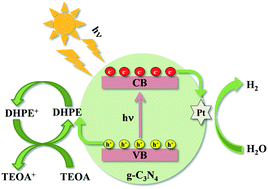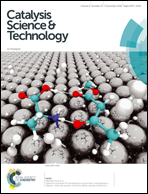Hantzsch ester as hole relay significantly enhanced photocatalytic hydrogen production†
Abstract
Polymeric graphitic carbon nitride (g-C3N4) has emerged as a promising semiconductor photocatalytic material, which can convert solar energy into chemical energy under visible-light irradiation. However, because of the issue of recombination of photogenerated electron–hole pairs, the photocatalytic efficiency of g-C3N4 is dissatisfactory. Herein, we constructed a novel system of graphitic-C3N4 composite photocatalyst (C3N4/DHPE) through π–π interactions and hydrogen bonds for efficient visible light-driven H2 evolution. The Hantzsch ester (diethyl 1,4-dihydro-2,6-3,5-pyridine dicarboxylate, denoted as DHPE) not only speeds up the transfer rate of photogenerated charge carriers, but also retards the recombination of electron–hole pairs through extracting holes from g-C3N4. C3N4/DHPE hybrid photocatalyst exhibits efficient spatial separation of photogenerated electrons and holes and thus, more electrons can be released for hydrogen production. When 4% DHPE was introduced, the hydrogen production rate of C3N4/DHPE photocatalyst drastically increased up to 1345.0 μmol h−1 g−1, which is 4.7 times higher than that of pure g-C3N4 (286.0 μmol h−1 g−1). Moreover, there is no significant decrease in H2 production after a long time reaction (20 h, five test cycles), confirming that the C3N4/DHPE photocatalyst has excellent stability. Our study offers a simple, cost-effective, and powerful route to promoting efficient separation of photogenerated charge carriers and a novel strategy to design other highly efficient photocatalytic systems for solar energy conversion.



 Please wait while we load your content...
Please wait while we load your content...